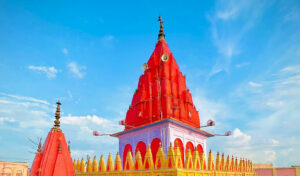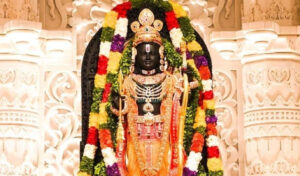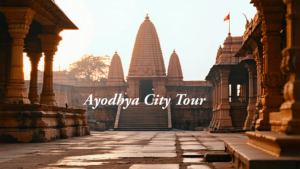Kanak Bhawan, Ayodhya – The Royal Palace of Rama & Sita
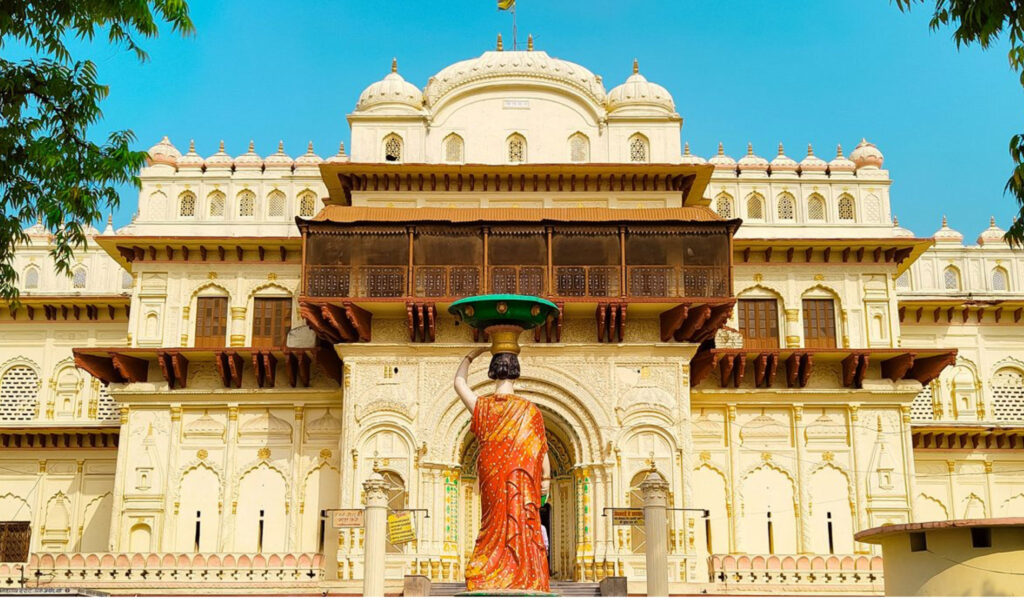
Nestled in the spiritual heart of Ayodhya, Kanak Bhawan is one of the must-visit Ayodhya sightseeing places. This ornate temple-palace, with its deep mythological roots and graceful architecture, offers a serene yet majestic experience. Whether you are a pilgrim seeking blessings or a traveller curious about legends, Kanak Bhawan is a top place to visit in Ayodhya, blending devotion, history, and art in one beautiful setting.
Where Is Kanak Bhawan? (with GPS Coordinates)
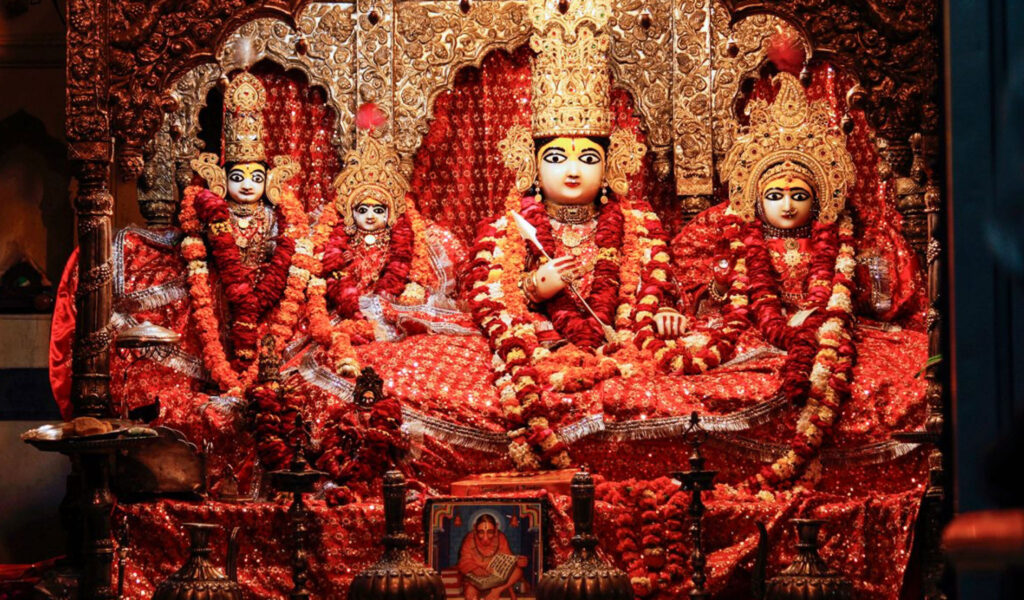
Kanak Bhawan is situated in the Sai Nagar / Kanak Bhawan Road area of Ayodhya, Uttar Pradesh, lying to the north-east of Ram Janmabhoomi (Ramkot). It forms part of the central cluster of sacred landmarks in Ayodhya, surrounded by other important temples, shrines, and ghats that make the city one of India’s most visited pilgrimage hubs.
•Latitude: 26.79635° N
•Longitude: 82.19635° E
These GPS coordinates can be entered directly into Google Maps to take you right to the temple gates.
Because of its prime central location, Kanak Bhawan is easy to access for both pilgrims and travellers. From Ayodhya Junction Railway Station, it is just a short rickshaw or auto ride away, while from Ram Janmabhoomi Mandir, many visitors simply walk to Kanak Bhawan as part of a circuit of nearby shrines.
Unlike the bustling courtyards of Ram Janmabhoomi, Kanak Bhawan offers a more peaceful, palace-like atmosphere. Its spacious courtyards, decorative arches, and serene ambience make it a welcome pause point for visitors navigating the many Ayodhya tourist attractions. Being in the heart of the holy city yet retaining its calm charm, it is an unmissable stop in any Ayodhya sightseeing places itinerary.
Mythological & Historical Significance of Kanak Bhawan
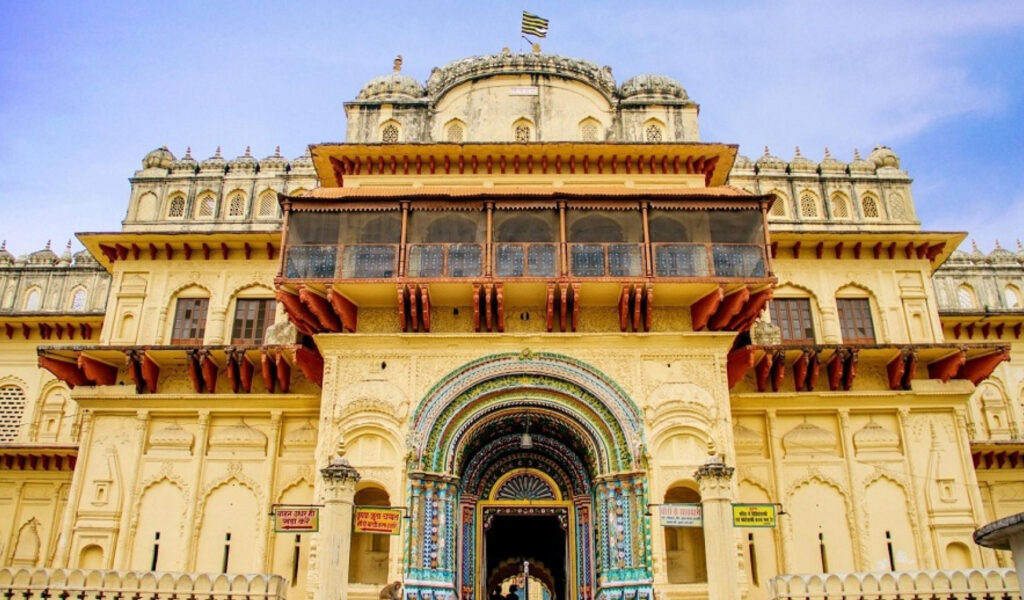
Kanak Bhawan is one of the most beloved Ayodhya tourist attractions, carrying with it centuries of legends and devotion that make it more than just a temple.
1. Gift of Kaikeyi
According to popular tradition, Kanak Bhawan was presented to Devi Sita by her step-mother Queen Kaikeyi shortly after her marriage to Lord Rama. In ancient custom, the “Muh-Dikhai” ceremony involved giving the new bride a gift, and Kaikeyi chose to give Sita a golden palace. Hence, it came to be called Kanak Bhawan (literally, “House of Gold”). This story highlights not only the grandeur of the palace but also the warmth and affection Sita received as she entered her new home in Ayodhya. The legend continues to live on, and devotees often refer to Kanak Bhawan as Sita’s royal residence, making it one of the most cherished Ayodhya places to see.
2. Renovations by Rulers
Over the centuries, Kanak Bhawan saw many changes. Historical records and local traditions suggest that King Vikramaditya of Ujjain, known for restoring Ayodhya’s ancient temples, played a role in rebuilding the palace-temple in earlier times. However, the most significant renovation was carried out in 1891 by Rani Vrish Bhanu Kunwari of Tikamgarh (Madhya Pradesh), who was a devoted follower of Lord Rama. Her contribution gave the temple much of its current form, layout, and splendour. Thanks to her patronage, Kanak Bhawan retains both a sense of historicity and the charm of a living devotional centre.
3. Devotional Center
Unlike many temples, Kanak Bhawan is revered as both a royal abode and a shrine. Inside the sanctum (garbhagriha), devotees find three pairs of idols of Lord Rama and Sita, each installed at different times in history. These idols are richly adorned with jewellery and colourful garments, reinforcing the idea of Rama and Sita residing here as a divine royal couple. For pilgrims, darshan at Kanak Bhawan feels like entering the home of Rama and Sita rather than visiting a conventional temple. This makes it a unique blend of mythology and living devotion, and one of the most spiritually fulfilling tourist spots in Ayodhya.
Kanak Bhawan’s story—from Kaikeyi’s golden gift to Rani Vrish Bhanu Kunwari’s restoration—captures the fusion of legend, royalty, and devotion. Today, it remains a shining symbol of Ayodhya’s sacred heritage.
Architecture of Kanak Bhawan
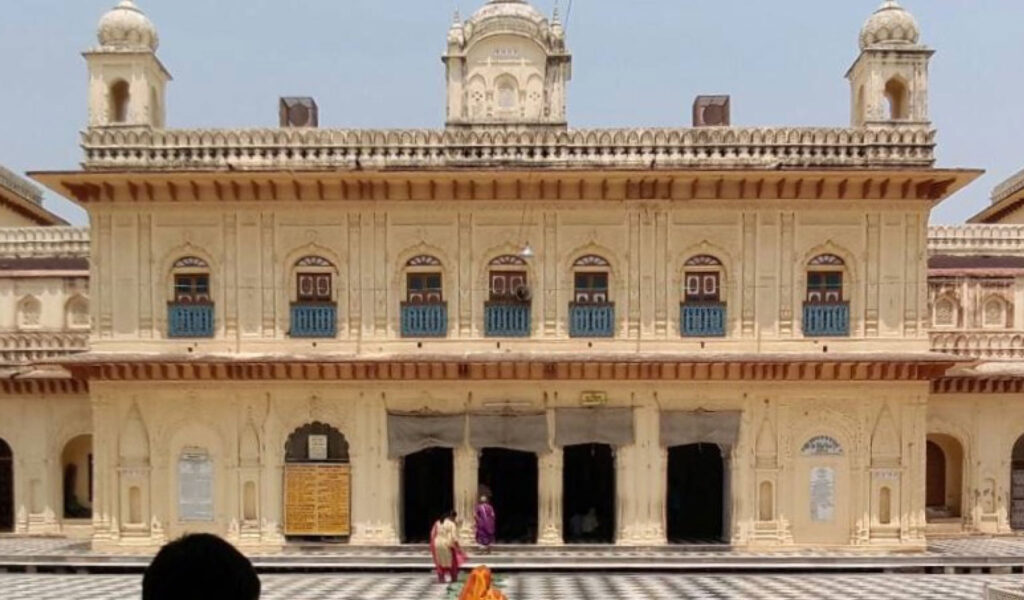
The architectural splendour of Kanak Bhawan makes it one of the most striking tourist spots in Ayodhya, combining the elegance of a royal palace with the sanctity of a temple.
1. Bundela Style Influence
The temple showcases the Bundela architectural style, prominent in the Bundelkhand region, known for its combination of intricate carvings, arched gateways, and domed pavilions. The structure’s flowing arches and ornate details bring a sense of grace and regality, reminiscent of the palace temples built by Rajput rulers. This stylistic choice makes Kanak Bhawan distinct from many other Ayodhya temples, giving it both historical charm and artistic depth.
2. Palatial Layout
Unlike a conventional shrine, Kanak Bhawan has the layout of a palace. Wide courtyards welcome visitors, flanked by high-ceilinged verandas and halls that emphasize openness and symmetry. The entrance arches from different sides lead into a central courtyard, evoking the experience of entering a royal residence rather than a religious monument. This design reinforces the legend of Kanak Bhawan being gifted to Sita as her palace, making it a living symbol of divine domesticity.
3. Three Pairs of Idols
The sanctum sanctorum (garbhagriha) houses three pairs of exquisitely adorned idols of Lord Rama and Devi Sita, each with its own story and timeline. The largest pair was installed by Rani Vrish Bhanu Kunwari in 1891, showcasing her devotion. The medium-sized pair is traditionally attributed to King Vikramaditya, while the smallest pair is associated with legendary origins, believed to date back to mythological times. These idols are decorated with jewellery, silk garments, and floral offerings, enhancing the aura of divine opulence.
4. Decorative Elements
The walls, ceilings, and pillars of Kanak Bhawan are richly decorated with carvings and paintings depicting scenes from the Ramayana. Mirror work and colour motifs reflect the fusion of palace aesthetics with devotional symbolism. Some accents, like gilded details and ornamented doorways, highlight its association with “Kanak” or gold. The temple’s interiors radiate warmth and splendour, creating an atmosphere where art and spirituality meet seamlessly.
With its palatial elegance, Bundela-inspired design, and richly adorned idols, Kanak Bhawan stands out as both a cultural and spiritual masterpiece. It is not just another Ayodhya place to see but a rare gem where mythology, artistry, and architecture coexist beautifully.
What You’ll See & Do at Kanak Bhawan
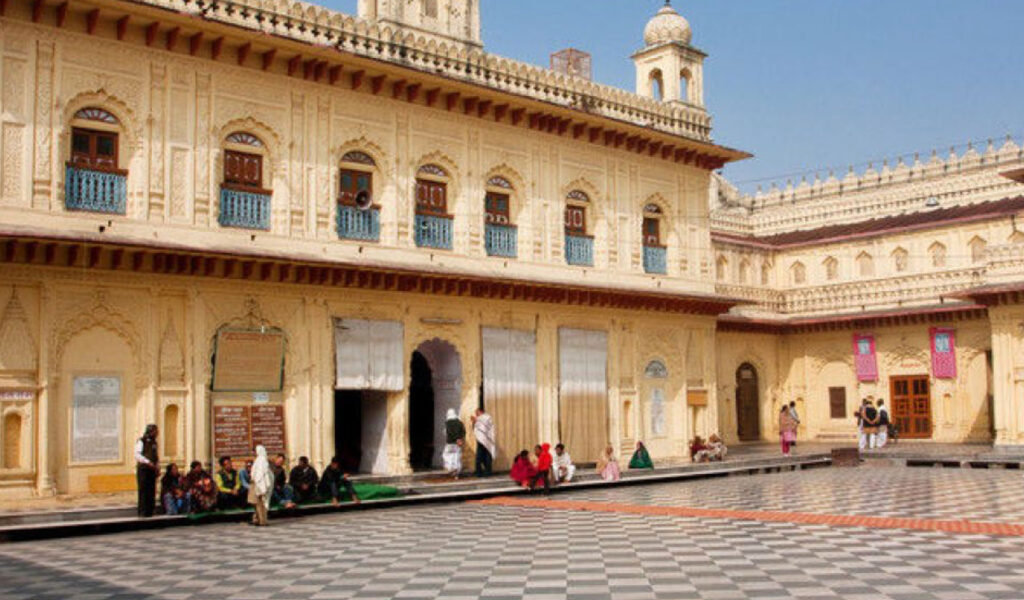
Visiting Kanak Bhawan offers a blend of devotion, myth, and peaceful exploration among Ayodhya sightseeing places:
•Darshan of Rama & Sita Idols: Pay respects at the garbhagriha, where the paired idols are worshipped daily. The larger idol pair installed by Rani Vrish Bhanu Kunwari is especially revered.
•Courtyards & Hallways: Stroll through the broad courtyard, the arched halls, and verandas. The architecture invites slow walking, reflection, photography.
•Legendary Stories: Learn the legends—Kaikeyi’s gift, the “Muh-Dikhai” ceremony (custom of showing the bride to elders), the tales of restoration. Priests often recite stories.
•Festivals & Celebrations: During Ram Navami, Janaki Navami, and other important dates, the temple is decorated, special pujas and bhajans are held. The atmosphere becomes vibrant.
•Quiet Moments: Sit in the temple garden or under shade, listen to temple bells, feel the spiritual ambiance. Since it’s centrally located but not as crowded as Ram Janmabhoomi, this is possible.
How to Reach Kanak Bhawan
Getting to Kanak Bhawan is quite convenient due to its central location:
•By Foot / Local Auto: From Ram Janmabhoomi or Hanuman Garhi, Kanak Bhawan is within walking distance or a short auto ride, given it’s in Ramkot / Sai Nagar area.
•By Train: Ayodhya Junction Railway Station is nearby, and local transport (rickshaw, auto) will take you directly to the temple.
•By Road: Ayodhya is connected via road to cities like Lucknow, Prayagraj, Varanasi etc. State bus services and private taxis are available. Once in Ayodhya, Kanak Bhawan is well signposted.
•By Air: The nearest functional airport is Bhagwan Valmiki International Airport, Ayodhya. From there, one can hire a cab to reach.
Nearby Places to Visit
Kanak Bhawan’s location makes it ideal to combine with other Ayodhya places to see:
•Sri Ram Janmbhoomi / Ram Mandir (very close) – the central pilgrimage site.
•Hanuman Garhi – hill temple, views over Ayodhya.
•Saryu River Ghats (Ram Ki Paidi) – for riverside walk, evening aarti.
•Surya Kund – peaceful pond nearby.
•Gupt Hari Ghat – for quieter reflections.
Best Time to Visit & Travel Tips
•Ideal Season: October to March, when weather is moderate; avoid peak summer heat.
•Morning or Evening Visits: Early morning when the temple is less crowded and cooler; evenings are beautiful for lighting and fewer people.
•Dress Modestly: As with other temples, cover shoulders and legs; remove footwear before entering sanctum.
•Photography: Allowed in outer courtyards, halls; be respectful inside sanctum.
•Festivals: On Ram Navami and Janaki Navami, expect larger crowds; arrive early if you want a calm experience.
Suggested Itinerary
Here’s a suggested half-day itinerary around Kanak Bhawan and nearby Ayodhya tourist spots:
•Morning: Start with Ram Janmbhoomi Mandir; then walk or auto to Kanak Bhawan for peaceful darshan.
•Late Morning: Proceed to Hanuman Garhi, then visit nearby Surya Kund or Gupt Hari Ghat.
•Afternoon: Lunch in local eatery; relax by Saryu River Ghats; enjoy aarti in the evening at Ram Ki Paidi.
For a full day, include lunch, local markets, possibly visiting Bharat Kund further out.
FAQs – Kanak Bhawan, Ayodhya
1.What is Kanak Bhawan?
Kanak Bhawan is a famous temple-palace in Ayodhya dedicated to Lord Rama and Goddess Sita. It is believed to have been gifted to Sita by Queen Kaikeyi after her marriage to Rama. The name “Kanak” means gold, reflecting its legendary royal status.
2.What are the temple timings and entry fee for Kanak Bhawan?
The temple timings are roughly 8:00 AM to 11:00 AM and 4:30 PM to 9:00 PM. There is no entry fee for visitors.
3.What is the mythological significance of Kanak Bhawan?
It is believed that Kanak Bhawan was the palace gift to Sita by Kaikeyi. Local legend holds that this “golden palace” depicts love, devotion, and respect in the Ramayana.
4.What architecture and idol features does Kanak Bhawan have?
The architecture shows Bundela style influences, with ornate carvings, arched doorways, domed pavilions. Inside the sanctum, there are three pairs of idols of Lord Rama and Sita—each pair installed at different historical times (one large, one medium, one small).
5.How long does it take to visit Kanak Bhawan?
Most visitors spend about 1 hour exploring Kanak Bhawan—darshan, seeing the idols, walking the courtyards, and enjoying the architecture.
6.Are there any dress code or rules?
Yes, visitors are expected to dress modestly (shoulders and legs covered). Also, usual temple etiquette applies—removing footwear, maintaining silence in sanctum, respecting rituals. Photography may have restrictions inside inner sanctum.
7.Is photography allowed inside Kanak Bhawan?
Generally yes in common areas and courtyards. Inside the sanctum, there may be restrictions during certain rituals—check locally for signboards or with temple staff.
8.What are the best times/seasons to visit?
October to March is considered the best time due to moderate weather. Visiting early in the morning or evenings is advisable to avoid heat and crowd. Festival days like Ram Navami, Janaki Navami are especially busy but spiritually rewarding.
9.How do I reach Kanak Bhawan from major transport hubs?
You can reach by road, auto-rickshaw or local transport within Ayodhya. Nearest railway station is Ayodhya Junction. Nearest airports include the new Ayodhya airport and Lucknow.
10.Are guide services or explanations available for visitors?
Yes, local guides are often available who can explain the legends, historical renovations, architecture, and significance. Devotees and visitors benefit from having such guidance for deeper understanding.
Conclusion
Kanak Bhawan is truly one of the most enchanting ayodhya tourist spots, combining myth, art, and devotion in one splendid setting. From its legendary origin as Sita’s golden palace to its elegant Bundela style architecture and the sacred idols it houses, it offers both spiritual nourishment and aesthetic delight. For anyone seeking the soul of Ayodhya beyond its major temples, Kanak Bhawan is a gem that should not be missed in your pilgrimage or travel plan.
Recommended Tour
Related Blogs
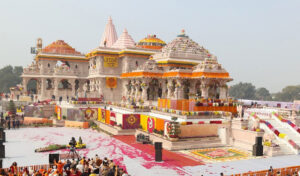
Sri Ram Janmbhoomi, Ayodhya – Where Divinity & History Meet
